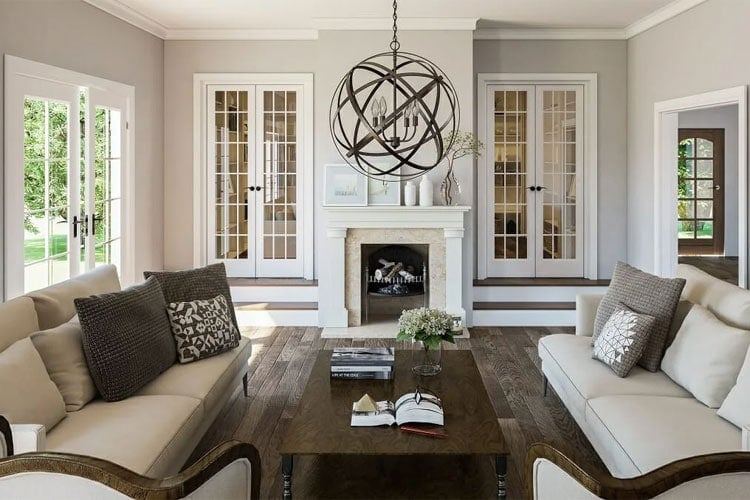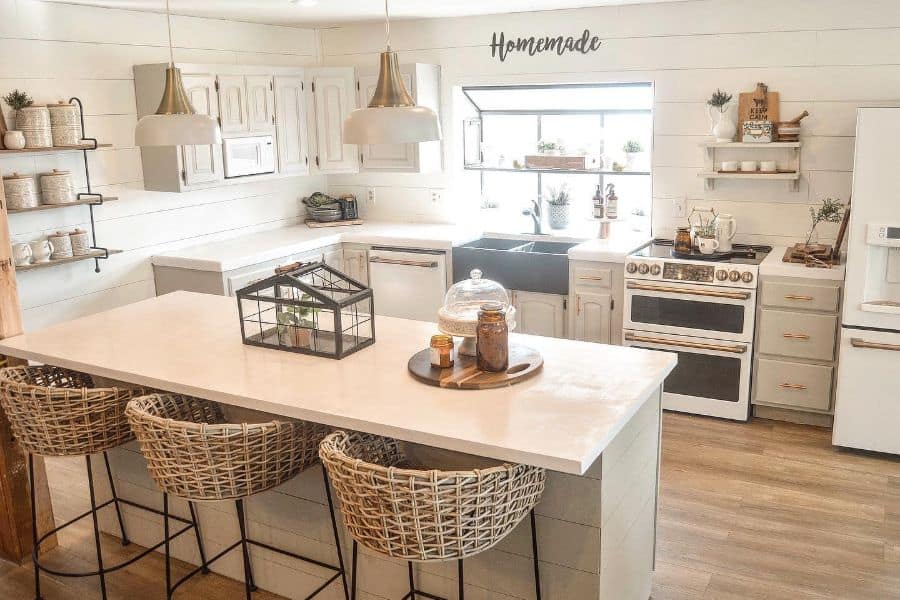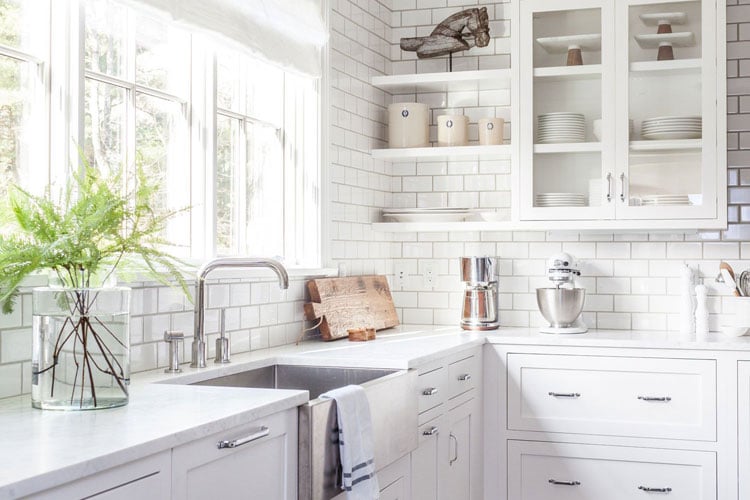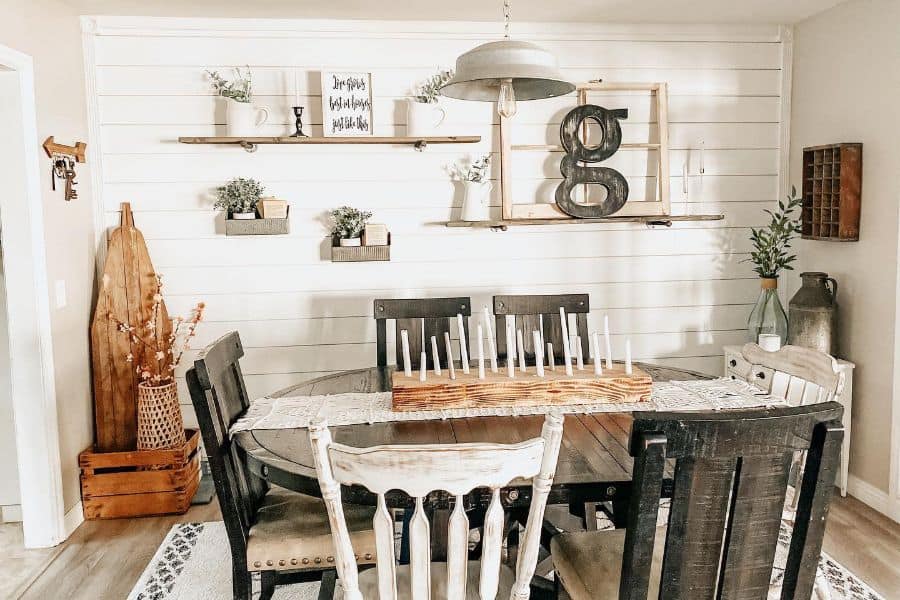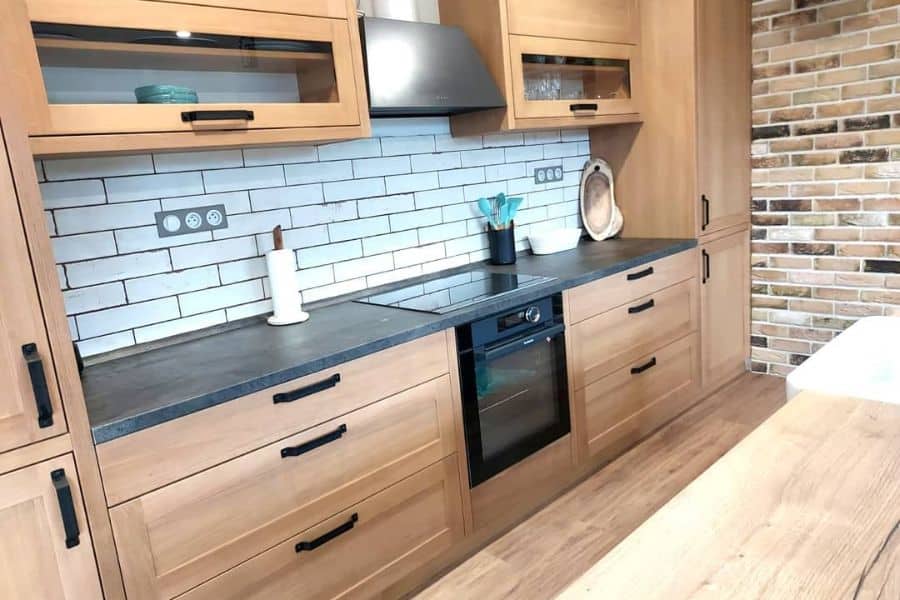Have you guys ever heard of transitional style? I kept seeing this term pop up everywhere and was so drawn to the photos.
I finally did some research and realized it’s this incredible way of making a space feel both timeless and totally new. It’s all about that comfortable, charming, and simple vibe, and I am completely hooked!
1. Furniture

I’ve heard some designers say that traditional design has a more feminine feel, while modern style reads as more masculine.
That’s probably why transitional decor is such a perfect solution when decorating a home for a couple, because it beautifully fuses those so called masculine and feminine qualities.
The furniture pieces in this style are so wonderful because they hold onto the comfy feel and curved shapes of traditional items, but they leave behind all the extra decorative bits.
You won’t see things like claw feet or ornate scrolled details that are so common in that classic style. This streamlining is a little nod to the sleek, understated lines of modern furniture.

You might find an upholstered piece that is super plush, maybe filled with goose down, and wrapped in a neutral, natural fabric. Then, it gets a fresh look with some colorful decorative pillows.
For wooden furniture, you could see it with a glossy lacquer finish or just left natural, which really just depends on your personal taste. Transitional pieces usually have a large scale, which gives them the power to really anchor a room.
The main takeaway here is that the furniture you pick should feel sophisticated and timeless, but you should never have to give up on comfort. I always say to invest in sturdy, classic furniture to really nail the look.
2. Living Room

When you start decorating a living room, the space you already have will really guide your furniture choices. If your room has that open layout with very few architectural details, you can bring in some traditional furniture to create a beautiful counterbalance.
I’m talking about pieces like a cozy Chesterfield sofa with a visible wooden frame, some big leather club chairs, or antique accent tables. You could also use tables with intricately carved legs and feet.
I love how furnishings from Queen Anne, Chippendale, or Victorian styles can bring in those classic elements.

Now, if your room already has beautiful details like scrolled wood trim or crown molding, your furniture should lean a bit more modern to create that perfect sense of balance.
You should still look for large, comfortable, overstuffed pieces, but their lines should be clean and sleek rather than curved.
As a general rule, your upholstered furniture should be in neutral shades to blend right in with the walls and floors. The accent pieces are where you can bring in those fun, bold pops of color.
A jewel toned overdyed rug with a quiet pattern can play off an assortment of bright decorative pillows so nicely.

You can also have fun juxtaposing abstract art with more classic paintings that share the same colors as your textiles. And please don’t be shy about bringing in lots of different textures!
Little accents like chrome picture frames, brushed metal light fixtures, and soft faux fur throws are what add that warmth and personality to the whole space.
3. Colors

The color palette is one area where traditional and modern decor really find some common ground, which I love.
With traditional style, you’ll usually see walls painted in neutral tones, but the textiles like curtains, pillows, and rugs often come in rich jewel tones. Using neutral colors gives transitional interiors such a stately and classically refined appearance.
With modern decor, the walls can be white, grey, or black, or another neutral shade that would feel perfectly at home in a traditional room.
In contemporary decorating, you’ll see art or textiles bring in bright pops of color that are meant to deliberately contrast with those stark walls.

It’s no surprise then that a transitional room will almost always be painted in neutral tones. Think white, tan, beige, gray, or sandy colors.
For those who are a bit more adventurous, you could bring in bolder colors like charcoal, black, and navy to add another layer of sophistication.
It doesn’t matter what neutral background you choose, because you will always be able to introduce bold, vibrant colors through your decorative objects.
Things like art, textiles, pillows, and unique furniture pieces are perfect for this. These colorful accessories and decorations are absolutely necessary for creating that perfect transitional style aesthetic.
4. Bedroom

When you bring the transitional look into the bedroom, choosing the right bed frame is key. It can be such an interesting focal point and really anchor the design for the rest of the room.
If your master bedroom has decorative accents like wainscoting, a sleek wooden bed frame with a chevron pattern can totally streamline the space.
If your room is already simple and understated, a tufted upholstered headboard in navy, gray, or beige will bring in a more luxe feel.

For the bedding, you have some great options. You could go with neutral shades like gray or cream, or bring in some vibrant colors like garnet, eggplant, or a deep forest green.
Instead of bedding with a really busy pattern, you could pick a solid colored pintuck or smocked duvet, which adds such a fun textural element.
I love to bring in decorative pillows in an assortment of colors and materials to add even more layers of interest. If you decide to use patterns, just be sure to keep them understated and tone on tone.

A room with more ornate details should have nightstands that are sleek and simple. They could be something like L shaped end tables with metal legs and a marble top, or even sleek chrome cylinders.
If your bedroom is lacking those architectural details, then bring in some antique Victorian or Queen Anne nightstands. Whichever direction you go, just make sure your dresser matches the style of the tables.
The table lamps for your nightstands should be simple and clean to help offset any ornate tables you choose.
5. Layout

Traditional homes tend to separate their spaces into very distinct rooms. They also often have those interesting historical details I love so much.
Modern homes are on the opposite end of the spectrum with their open floor plans and minimal decorations.
And once again, transitional style perfectly marries these two competing aesthetics. A home decorated in this way often keeps the modern open floor plan but also incorporates those interesting architectural details from traditional design.

What kind of features am I talking about? Things like wainscoting, crown molding, a chair rail, or even a coffered ceiling. Intricate details like these can have such a big impact in an open layout, it’s just stunning.
6. Decorative Materials
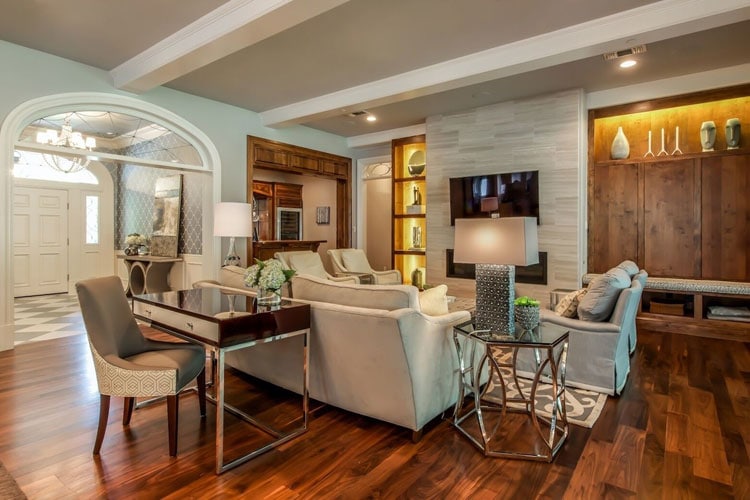
When it comes to decorative items, traditional and modern designs have very different philosophies. A traditional space might be filled with lots of interesting pieces, while a more modern space is going to be sleek and uncluttered, reflecting that minimalist approach.
A transitional decorating style actually follows the modern sensibility more closely when it comes to minimalism.

For the decorative materials themselves, transitional design pulls inspiration from both of its parent styles. You’ll see wood, rattan, and textiles made from natural fabrics, which are drawn from traditional decor.
At the same time, you’ll find materials like steel, glass, and lacquer, which are all nods to contemporary concepts.
7. Lighting and Accessories

Traditional lighting is usually ornate and really attention grabbing. A crystal chandelier would be perfectly at home in a traditional space.
Modern lighting, on the other hand, is typically very understated and might be something like simple pendant lighting or another unadorned fixture.
So, as you can probably guess, transitional lighting will feature elements from both of these design styles.
The lighting in this style often mimics the large size and intricate shape of traditional fixtures, but it incorporates more modern finishes like sleek chrome or a brushed metal.
8. Flooring
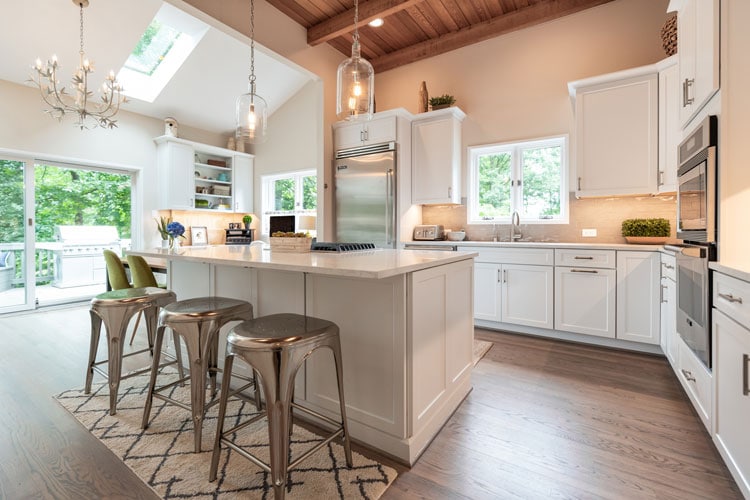
When it comes to picking out modern flooring, the sky is really the limit. You can choose floors made from a huge array of materials, like wood, bamboo, stone, laminate, tile, cork, and even concrete.
Traditional homes are on the opposite end of things, as the floors are almost always made from hardwood, without exception. That traditional hardwood is often birch, cherry, or maple, and it’s stained a rich, dark brown or a deep red.

Just like with traditional flooring, transitional floors are generally made of hardwood. But, it gets a modern facelift with the help of lighter stains. You’ll often see transitional flooring that is whitewashed or warmed up with a golden, honey colored stain.
If you’re feeling extra bold, you can lay these hardwood floors down in a chevron or herringbone pattern to add some amazing visual interest.
You can also use tile in the bathroom and kitchen for some added modern flair. I think hexagonal tiles add such a stylish and forward thinking element to a space.

